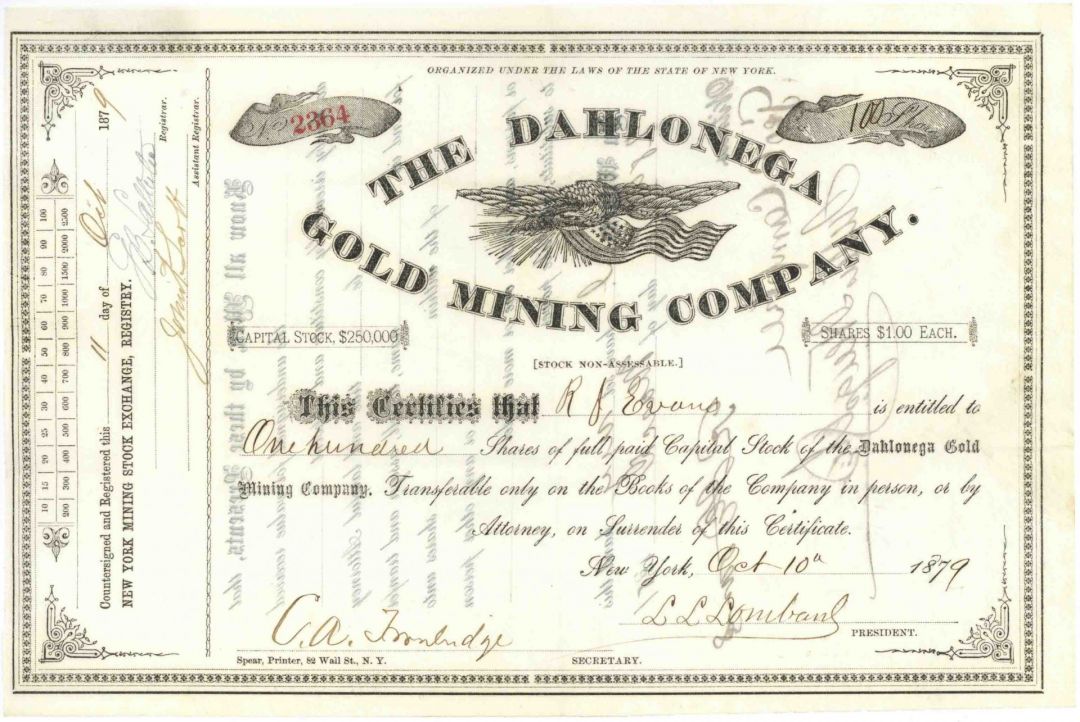Dahlonega Gold Mining Co. - 1879-80 dated Georgia Mining Stock Certificate - Dahlonega Coin Mint History
Inv# MS1995 StockNew York
Stock. Great history in Dahlonega, Georgia. The Dahlonega Mint served as a branch of the United States Mint, established during the Georgia Gold Rush to facilitate the assaying and minting of gold for miners, thereby eliminating the need for them to travel to the Philadelphia Mint. It was situated at coordinates (34°31.8?N 83°59.2?W) in Dahlonega, Lumpkin County, Georgia. Coins minted at this facility are distinguished by the "D" mint mark, which is currently utilized by the Denver Mint, inaugurated in 1897, more than thirty years after the closure of the Dahlonega Mint. All coins produced at the Dahlonega Mint are composed of gold and are available in denominations of $1, $2.50, $3, and $5, with minting dates ranging from 1838 to 1861.
The Georgia Gold Rush represents the second major gold rush in the United States and the first within Georgia, eclipsing the earlier rush in North Carolina. It commenced in 1829 in what is now Lumpkin County, near the county seat of Dahlonega, and rapidly extended throughout the North Georgia mountains, tracing the Georgia Gold Belt. By the early 1840s, the availability of gold diminished significantly, prompting many miners to migrate westward following the discovery of gold in the Sierra Nevada in 1848, which initiated the California Gold Rush. Since the 16th century, Native Americans in Georgia had informed European explorers that the limited quantities of gold they possessed originated from the interior mountains. There are some poorly substantiated reports of Spanish or French mining activities in North Georgia between 1560 and 1690, but these are largely based on conjecture and rumors relayed by Indigenous peoples.
In summarizing the available evidence, W.S. Yeates remarked, "Many of these accounts and traditions seem to be quite plausible. Nevertheless, it is hardly probable that the Spaniards would have abandoned mines which were afterwards found to be quite profitable, as those in North Georgia.”
The accuracy of the original discovery remains uncertain. Various accounts attribute the find in White County, Georgia, along Dukes Creek, to either Frank Logan or his enslaved individual. Another narrative suggests that John Witherood (also referred to as Witherow or Withrow) discovered a three-ounce nugget in the same area. Additionally, there is a claim that Jesse Hogan, a prospector from North Carolina, unearthed gold near Dahlonega, Georgia, specifically at Ward's Creek. It is also reported that Thomas Bowen located gold in the roots of a tree that had been uprooted by a storm along Dukes Creek. Furthermore, Benjamin Parks is said to have discovered gold on his birthday in 1828 while traversing a deer path, leading him and his business associate, Joel Stephens, to lease the site from Reverend O'Barr.
In 1831, estimates indicated that there were between 6,000 and 10,000 miners operating in the area between the Chestatee River and the Etowah River. This period saw the emergence of boom towns such as Auraria and Dahlonega, with the latter reportedly supporting as many as 15,000 miners at the peak of the gold rush. The influx of prospectors and settlers led to heightened tensions with the Cherokee Nation. Soon, gold mines began to proliferate across various counties in the North Georgia mountains, including Rabun, the northeasternmost county in Georgia. In 1838, Congress established the Dahlonega Mint as a branch of the United States Mint, reflecting the significant gold production occurring in Georgia. The creation of the Dahlonega Mint served to legitimize the state's earlier actions to appropriate Cherokee lands. When news of the California Gold Rush reached Georgia, numerous miners migrated westward in pursuit of greater fortunes. In an effort to persuade them to remain, M. F. Stephenson, the assayer of the Dahlonega Mint, addressed a gathering of miners from the steps of the courthouse, proclaiming, "Why go to California? In that ridge lies more gold than man ever dreamt of. There's millions in it."
A stock certificate is issued by businesses, usually companies. A stock is part of the permanent finance of a business. Normally, they are never repaid, and the investor can recover his/her money only by selling to another investor. Most stocks, or also called shares, earn dividends, at the business's discretion, depending on how well it has traded. A stockholder or shareholder is a part-owner of the business that issued the stock certificates.











Ebay ID: labarre_galleries